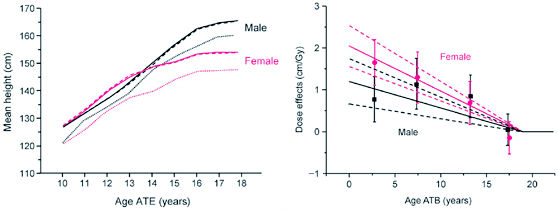Effects on Physical Growth and Development
Body measurements (height, weight, chest circumference, etc.) have been taken at ABCC-RERF as indices of growth in young A-bomb survivors. Findings show that growth retardation has been a general result of childhood exposure to bomb radiation. The left figure represents the results of fetal exposure cases; while no clear dose effect was seen among those who were exposed to <1 Gy, larger doses (≥1 Gy) did cause decreased adult height by about 6 cm (or about 2.5 cm per Gy). The effect was already seen at age 10, but the subsequent pubertal growth spurt was not affected. The right figure represents the results of exposure at various ages, which used the first height information after age of 20 years. The radiation effect seems to be more pronounced among females than in males. Studies were also conducted regarding age at menarche among female survivors, but no radiation effects were seen. Recent data, however, suggest a possibility that radiation exposure has led to an earlier menopause.

Figure. Radiation effects on height. Left panel indicates results on fetally exposed survivors measured at ages from 10 to 18 years. The X-axis represents height and the Y-axis the age at the time of examination (ATE). The solid line represents 0 mGy control subjects, dashed line 1-999 mGy group, and dotted line ≥1,000 mGy group (DS86 uterus dose). The right panel shows the effects of 1 Gy exposure at different ages. The X-axis represents the age at exposure and the Y-axis the radiation effects in cm per Gy. Circles represent females and squares males. Vertical bars indicate 95% confidence intervals (CI) at various age ATB, and dashed lines 95% CI of the linear regression line.

